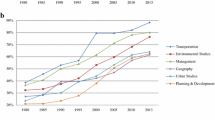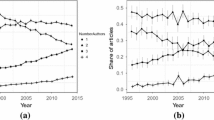Abstract
Co-authorship analysis is a well-established tool in bibliometric analysis. It can be used at various levels to trace collaborative links between individuals, organisations, or countries. Increasingly, informetric methods are applied to patent data. It has been shown for another method that bibliometric tools cannot be applied without difficulty. This is due to the different process in which a patent is filed, examined, and granted and a scientific paper is submitted, refereed and published. However, in spite of the differences, there are also parallels between scholarly papers and patents. For instance, both papers and patents are the result of an intellectual effort, both disclose relevant information, and both are subject to a process of examination. Given the similarities, we shall raise the question as to which extent one can transfer co-authorship analysis to patent data.
Similar content being viewed by others
References
Bhattacharya, S., Khan, M. T. R. (2001), Monitoring technology trends through patent analysis: A case study of thin film. Research Evaluation, 10 (1): 33–45.
Bhattacharya, S., Kretschmer, H., Meyer, M. (2003), Characterizing intellectual spaces between science and technology. Scientometrics, 58 (2): 369–390.
Bhattacharya, S., Meyer, M. (2003), Large firms and the science-technology interface-Patents, patent citations, and scientific output of multinational corporations in thin films. Scientometrics, 58 (2): 265–279.
Carayannis, E. G., Laget, P. (2004), Transatlantic innovation infrastructure networks: public-private, EU-US R & D partnerships. R & D Management, 34 (1): 17–31.
Danell, R., Persson, O. (2003), Regional R & D activities and interactions in the Swedish Triple Helix, Scientometrics, 58 (2): 205–218.
Etzkowitz, H., Webster, A., Gebhardt, C., Terra, B. R. C. (2000), The future of the university and the university of the future: evolution of ivory tower to entrepreneurial paradigm. Research Policy, 29 (2): 313–330.
GlÄnzel, W. (2001), National characteristics in international scientific co-authorship relations. Scientometrics, 51 (1): 69–115.
GlÄnzel, W., Schubert, A. (2001), Double effort = Double impact? A critical view at international co-authorship in chemistry. Scientometrics, 50 (2): 199–214.
GlÄnzel, W., Schubert, A. (2004), Analyzing scientific networks through co-authorship, In: H. MOED, W.
GlÄnzel, U. Schmoch (Eds), Handbook of Bibliometric Indicators for Science and Technology, Kluwer Academic Publishers, Dordrecht.
Katz, J. S., Martin, B. R. (1997), What is research collaboration? Research Policy, 26 (1): 1–18.
Kretschmer, H. (1997), Patterns of behaviour in coauthorship networks of invisible colleges. Scientometrics, 40 (3): 579–591.
Laudel, G. (2001), What do we measure by co-authorships? Research Evaluation, 11 (1): 3–15.
Melin, G., Persson, O. (1996), Studying research collaboration using co-authorships. Scientometrics, 36 (3): 363–377.
Meyer, M. (2000a), What is special about patent citations? Scientometrics, 48 (2): 151–178.
Meyer, M. (2000b), Does science push technology? Patents citing scientific literature. Research Policy, 29 (3): 409–434.
Meyer, M. S. (2001), Between Technology and Science-Exploring an Emerging Field. Knowledge Flows and Networking on the Nano-scale. DPhil thesis, University of Sussex, Brighton.
Meyer, M. (2003), Are academic patents an indicator of useful university research? Research Evaluation, 12 (1): 17–27.
Meyer, M., SinilÄinen, T., Utecht, J. T. (2003), Towards hybrid Triple Helix indicators-A study of university-related patents and a survey of inventors. Scientometrics, 58 (2): 321–350.
Narin, F., Stevens, K., Whitlow, E. S. (1991), Scientific cooperation in Europe and the citation of multinationally authored papers. Scientometrics, 21 (3): 313–323.
Pavitt, K. (1998), The social shaping of the national science base. Research Policy, 27 (8): 793–805.
Price, D. De Solla (1965), Is technology historically independent of science? A study in statistical historio-graphy. Technology and Culture, 6 (4): 553–568.
Price, D. De Solla (1984), The science/technology relationship, the craft of experimental science, and policy for the improvement of high technology innovation. Research Policy, 13 (1): 3–20.
Walker, R. D. (1995), Patents as Scientific and Technical Literature. The Scarecrow Press: Metuchen, NJ and London.
Author information
Authors and Affiliations
Rights and permissions
About this article
Cite this article
Meyer, M., Bhattacharya, S. Commonalities and differences between scholarly and technical collaboration. Scientometrics 61, 443–456 (2004). https://doi.org/10.1023/B:SCIE.0000045120.04489.80
Issue Date:
DOI: https://doi.org/10.1023/B:SCIE.0000045120.04489.80




